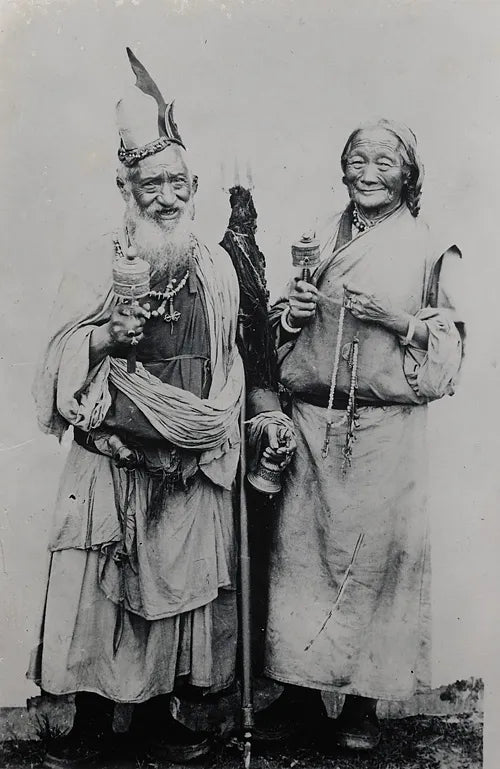
A place irrelevant to the Tibetan people: Shangri-La (2)

Photographed by Johanna Elisabeth Meyer, in the collection of Preus Museum.
Please take off your glasses!
They cannot represent themselves,
they must be represented by others.

White utopia
As mentioned in the previous issue, Hilton weaved a utopian dream full of poetry and fantasy, drifting with pastoral melodies, with magnificent and romantic words. Shangri-La, a secluded valley away from human habitation, turned out to be a rich and charming paradise, with temperature changing with altitude, ranging from warm to hot to cool; the land is cultivated efficiently, with a variety of crops and a bountiful harvest in sight. At noon, one can enjoy the warm sunlight here, with snow melting into clear streams flowing through the valley from the snow-capped peaks; the warm breeze caresses everything, even the shady spots feel no trace of cold.

Lost Horizon still, 1973
The indigenous people are all of mixed Han and Tibetan descent, clean, handsome, and possess many excellent qualities that other ethnic groups do not have. They have lived for generations in peaceful and tranquil valleys, with joyous laughter filling the fields, roadsides, village entrances, and tea pavilions. They warmly greet passersby, are gentle and courteous, open and carefree, focusing on their work without a trace of busyness or fatigue.




Lost Horizon album back cover, 1973
Is it really the case?
In this picturesque paradise on earth, the venerable Rinpoche has ruled for

The character of "Mr. Chang" in Lost Horizon, 1973
There is no doubt that in this seemingly perfect utopia, a small group of noble Europeans are the absolute rulers. The worldly-wise Han Chinese bureaucrat,
Even longevity is inevitably linked to the ethnicity itself. Quoting a statement by Rinpoche:
We find that, in general, Tibetans are not as fragile as other ethnic groups because they are accustomed to high-altitude environmental conditions; and they are kind-hearted, so we have taken in quite a few of this ethnic group, but I don't think many people have lived to be over 100 years old. Han people are slightly better, but we believe the best candidates are some European Latin and Germanic people, or Americans.

Orientalism
"The East" is almost a European invention. It has been since ancient times a place filled with romantic legends and exotic flavors, lingering in people's memories and visions, with unique experiences. As Edward Wadie Said (1935-2003) said:
Stories are the core content of colonial explorers and novelists telling tales of distant lands, also becoming a way for colonized people to affirm their identity and historical existence. In the myth-making of Shangri-La, the desire of Western imperialism to control the resources of the East becomes the underlying force of the narrative.


"Gold, young man, gold! There are thousands of gold in the canyon... I have obtained full permission from the authorities to mine as much as I want... They need me as an expert, I will tell them how to increase the mining output."
Just as Mr. Zhang said in the text:
"Blinkroshojie is determined to change our beliefs, while Mr. Barnard is thinking
This logic is no different from that of colonialists wearing Easternist glasses throughout history. They naturally believe that the East is full of gold and treasures waiting to be discovered, and that the limited knowledge and skills of the Eastern people cannot uncover these treasures, it is simply a waste. With the belief in Christian universalism, Westerners not only have the ability but also the right to exploit and extract, which can bring wealth to themselves and provide an opportunity for the East to transform into modern civilization.
Under the aura of the empire, Westerners seem to be messengers of advanced civilization, and even penniless poor people, dying victims, and full-fledged villains can find ecstatic joy in overlooking the superiority of Eastern civilization. Shangri-La has thus become a paradise for Western adventurers and a heaven for speculative businessmen. Just as Sayyid said:
"In the novels, history, travelogues, and explorations of colonists, they are also portrayed as vibrant. This vitality comes not only from colonial activities, but also from the geography and people of exotic places."


Imagination and construction are everlasting themes of Orientalism. The Italian writer Italo Calvino (1924-1985) once wrote a fantastical novel called "Invisible Cities" in which he said:
"The world is built on human perceptions, in each place, in the human mind, there is a specific meaning, it may be a hometown or a foreign land, it may be familiar or dangerous, desirable or terrifying; in each meaningful place, it becomes the environment of our existence and constitutes the meaning of our existence. Imagination speaks of these meaningful places 'embedded' in this world. These 'places' reach from a continent, east or west, as small as a corner of a home or a drawer on a desk..."




In essence, this kind of Shangri-La is the spiritual coordinates that Westerners
extra words


